In 2023, learning and development must offer far more than just skills for the organization to optimize its staff’s capabilities.
Learning must be stimulating, relevant and interoperable across departments and companies, allowing staff to become more agile, constantly learning in a fluctuating market and boosting employee retention.
To highlight the need for greater interoperability in L&D, the LinkedIn Workplace Learning Report 2022 shows that 74% of companies agree that L&D has become more cross-functional.
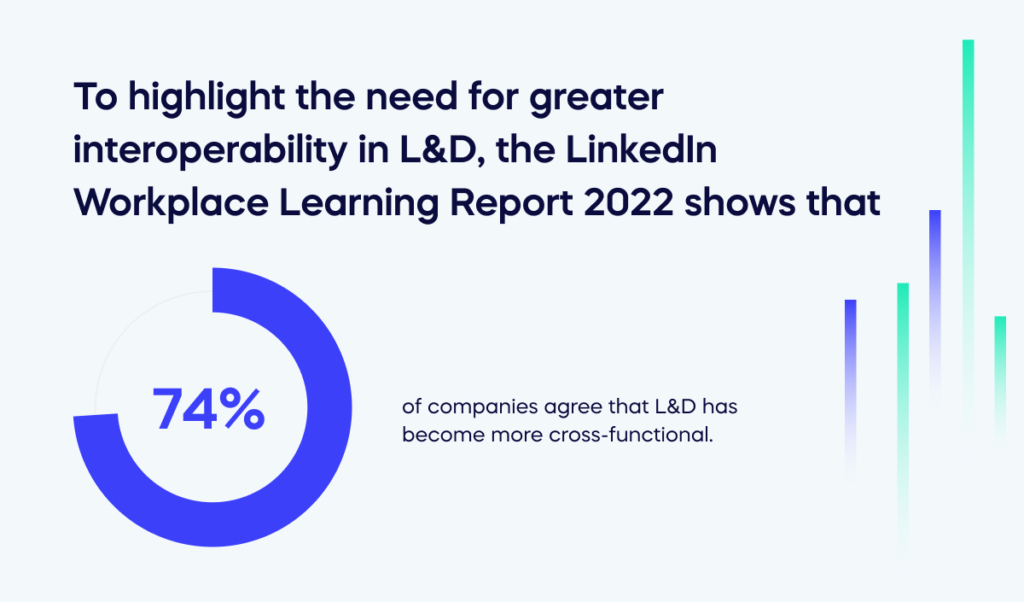
SCORM compliance is one of the most effective ways of rolling out training quickly and easily across businesses in a portfolio and departments within a company with SCORM-compliant content on Elearning courses.
To show you how to become SCORM compliant, we will cover the following topics within our quick and easy guide for 2023:
- What does SCORM compliant mean?
- What are the advantages and disadvantages of SCORM?
- How is SCORM compliance assessed?
- How do you become SCORM compliant?
What does SCORM compliant mean?
When we separate the terms SCORM and SCORM compliance, they are easier to understand. Let’s first look at SCORM.
SCORM
SCORM (Sharable Content Object Reference Model) is a set of standards to ensure learners across all platforms can use all learning materials.
Companies use this system to roll out training across departments and companies within a portfolio. Hence, all employees learn the same content in the same way for consistent business processes and cohesive company culture, as the barriers to organizational learning are reduced.
Visual learner? Check out the 90-second video below to understand a little more about SCORM.
SCORM compliant
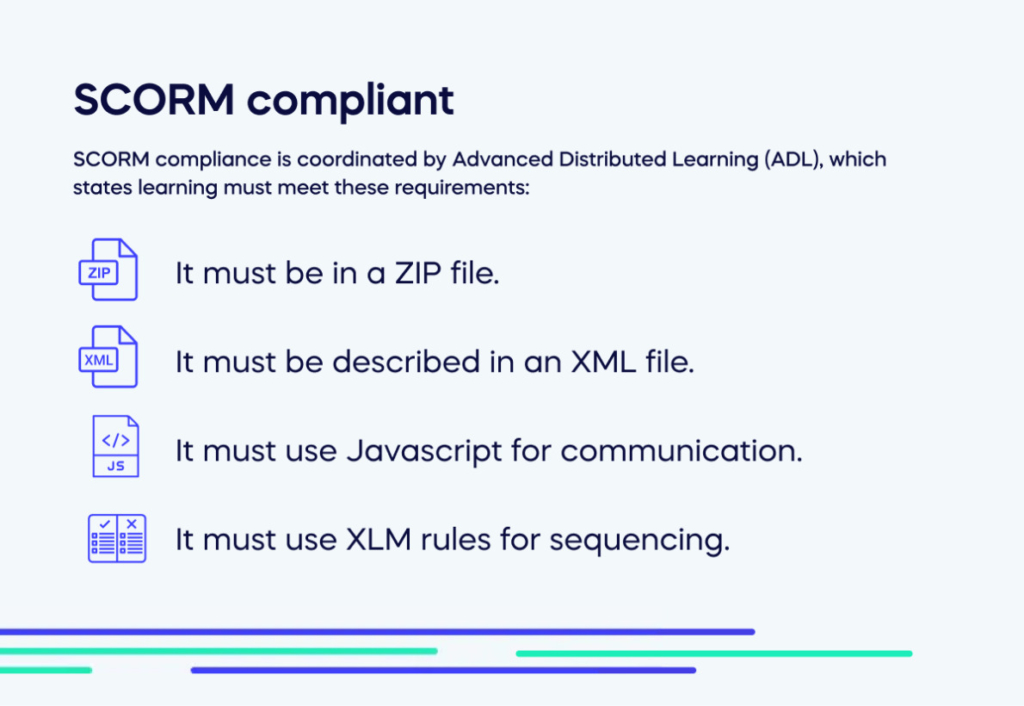
SCORM compliance is coordinated by Advanced Distributed Learning (ADL), which states learning must meet these requirements:
- It must be in a ZIP file.
- It must be described in an XML file.
- It must use Javascript for communication.
- It must use XLM rules for sequencing.
These are the basic requirements of SCORM compliance, but the criteria for approving compliance go into more depth, as described below in the ‘How is SCORM compliance assessed’ section.
What are the advantages and disadvantages of SCORM?
On the surface, building SCORM-compliant courses seems like an ideal way to allow staff from different departments and businesses within your portfolio to use training on their preferred LMS (learning management system).
However, before transferring to a SCORM-compliant LMS as part of your learning management systems digital transformation, there are advantages and disadvantages to consider.
Use these advantages and disadvantages to decide how SCORM courses might work for you and whether it is worth the investment.
Advantages
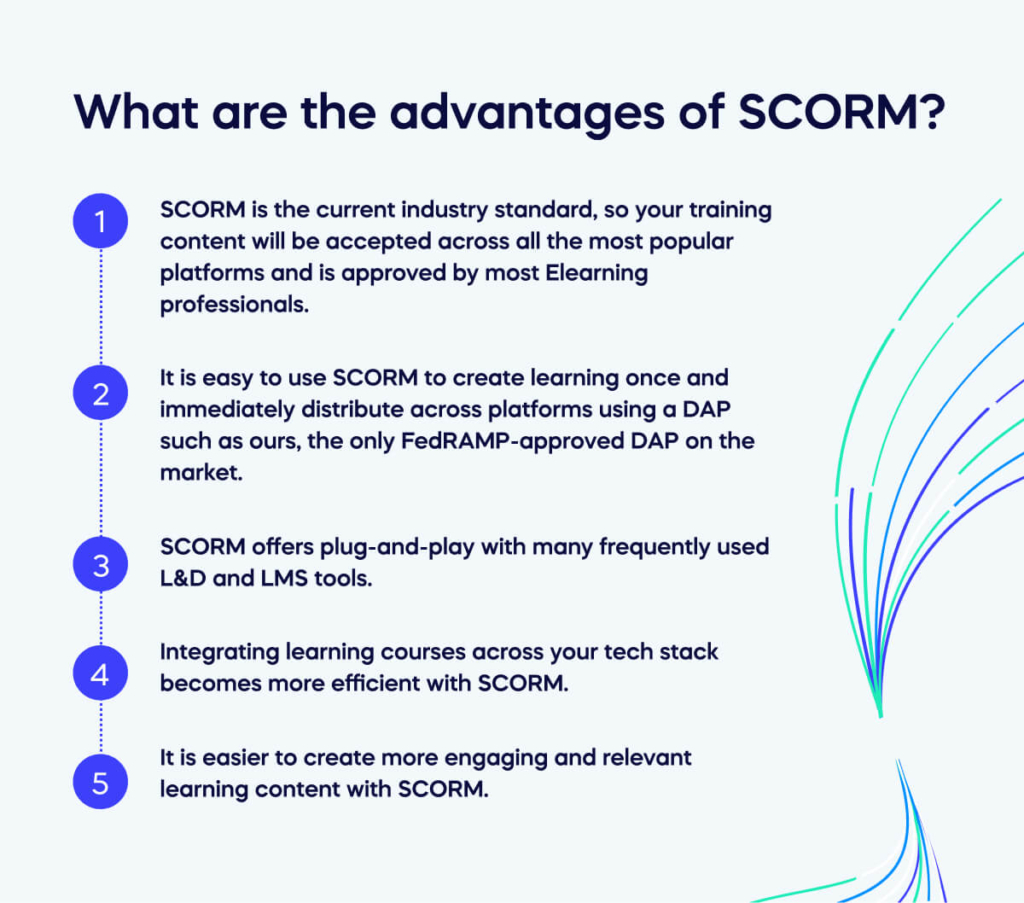
There are many advantages to SCORM, making compliance an attractive prospect.
- SCORM is the current industry standard, so your training content will be accepted across all the most popular platforms and is approved by most Elearning professionals.
- It is easy to use SCORM to create learning once and immediately distribute across platforms using a DAP such as ours, the only FedRAMP-approved DAP on the market.
- SCORM offers plug-and-play with many frequently used L&D and LMS tools.
- Integrating learning courses across your tech stack becomes more efficient with SCORM.
- It is easier to create more engaging and relevant learning content with SCORM.
Disadvantages
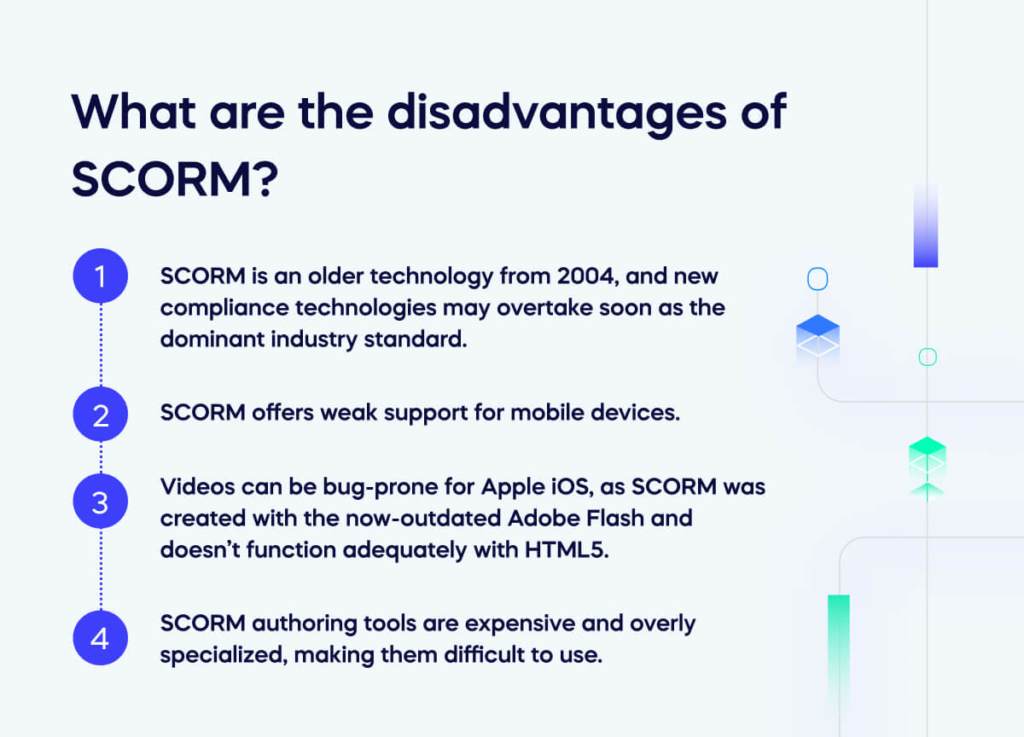
It is necessary to consider the disadvantages of SCORM to justify its ROI.
- SCORM is an older technology from 2004, and new compliance technologies may overtake soon as the dominant industry standard.
- SCORM offers weak support for mobile devices.
- Videos can be bug-prone for Apple iOS, as SCORM was created with the now-outdated Adobe Flash and doesn’t function adequately with HTML5.
- SCORM authoring tools are expensive and overly specialized, making them difficult to use.
Use examples from your business against each of these advantages and disadvantages to ensure SCORM compliance is relevant to your organization before investing, to reduce waste, and ensure L&D success.
How is SCORM compliance assessed?
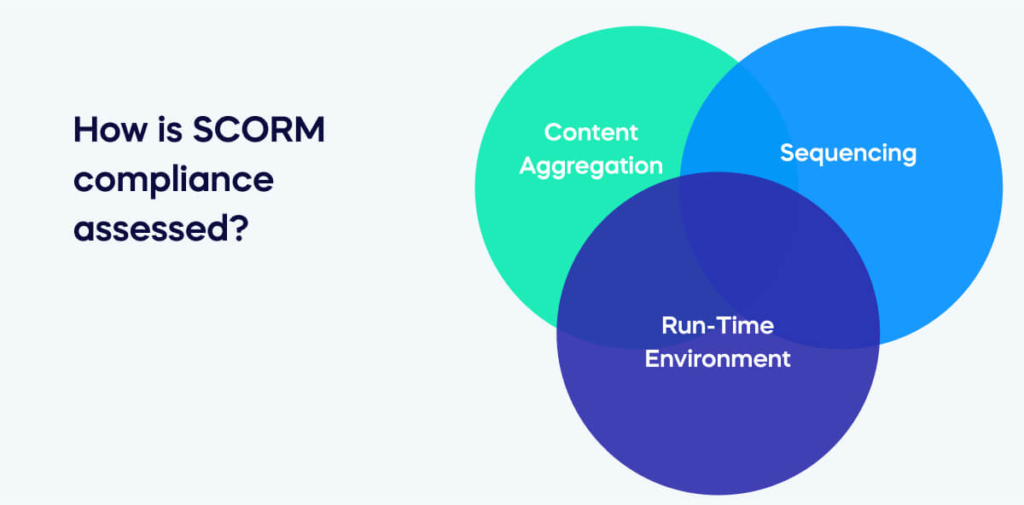
ADL uses three main criteria to assess SCORM compliance with learning materials. The first of these criteria is content aggregation.
1. Content Aggregation
SCORM Content Aggregation Model (CAM) is like a rule book for how systems and authoring tools send eLearning content. It tells people how to pack the content in ZIP files and make sure that others can find it with unique information called metadata.
2. Run-Time Environment
SCORM Run-Time Environment (RTE) uses a standardized data model and API to bridge the gap between your learning management system (LMS) and training material. This ensures compatibility and accurate tracking of learner engagement data.
3. Sequencing
SCORM helps people make rules for how people go through a course. These rules tell the learner which parts of the system they should do first, next and last. The XML contains sequencing rules that enable course authors and training managers to utilize a tool that:
- Monitor and track your progress in learning.
- Design navigation tools for students.
- Prioritize more important learning modules.
- Automate the process of improving skills that have not yet been mastered.
How do you become SCORM compliant?
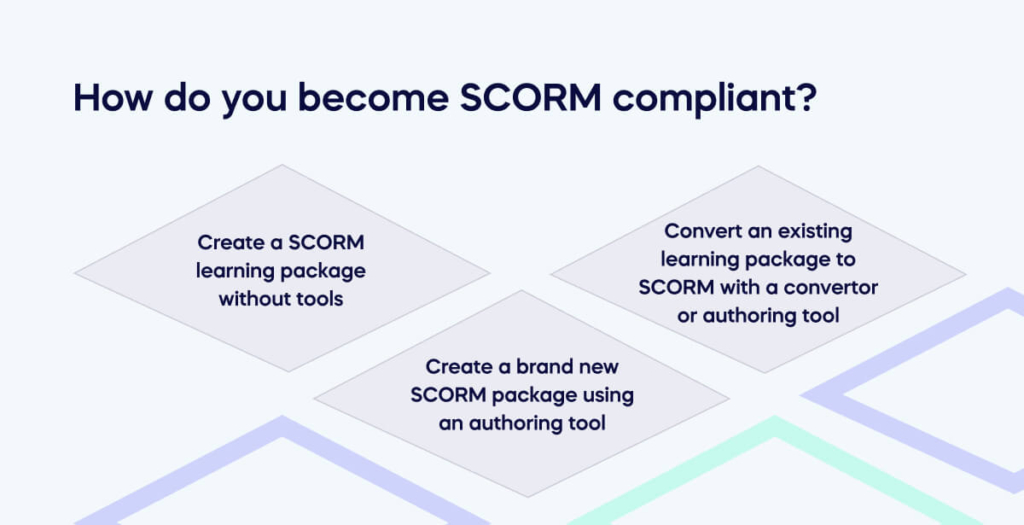
There are three options for becoming SCORM-compliant with your learning packages. The first is to create a SCORM learning package independently without using any extra tools.
If this isn’t an option for you, other routes are to create a SCORM package from scratch or convert an existing package to SCORM.
Consider each option described below to help you decide the best route for your organization to become SCORM compliant.
Create a SCORM learning package without tools
The first option is to create a SCORM package without using tools.
What it involves
Creating a SCORM package without specialized authoring tools reduces financial waste but requires specialist knowledge and experience.
This process has multiple stages, unlike the other SCORM compliance routes. This point means that specialized and experienced members of staff must carry it out to ensure that the short-term financial benefits could are not replaced with frustration as projects are not completed to schedule.
Who it’s best for
Creating a SCORM package without tools is best for:
- New subsidiary companies with limited resources but specialized developers within the team.
- Teams that need specialized, tailored training for specific purposes must be interoperable.
Create a brand new SCORM package using an authoring tool
Authoring tools that have many features can do more than just convert files. With these tools, instructional designers of any skill level can create interactive content.
What it involves
SCORM course development is no longer limited to professional programmers; anyone can create them using SCORM authoring tools. Many easy-to-use tools, including PowerPoint add-ins, allow for simple course creation.
Using an authoring tool can be an excellent introduction to some of the principles and dynamics of SCORM compliance in a guided form.
Who it’s best for
The brand new SCORM package using an authoring tool method is best for:
- New enterprise startups with zero existing training packages that they need to use across departments.
- Companies that want to transform their culture through innovative training packages across many teams.
- Organizations looking to train staff as part of a digital transformation project.
Convert an existing learning package to SCORM with a convertor or authoring tool
The final option is converting the existing learning package to make it SCORM-compliant.
What it involves
Creating one SCORM course manually could be fun and teach you new skills. However, if your job demands creating many SCORM lessons with lots of audio and video, the task can take several months of monotonous coding and editing SCORM files.
Fortunately, specific software programs known as SCORM authoring tools can handle the coding and packaging tasks, allowing you to focus solely on instructional design and save time.
Using these tools, you can convert your courses from visual content to SCORM packages compliant with HTML and easily uploaded to an LMS.
Who it’s best for
The conversion route is best for:
- Established enterprises with many learning packages
- Enterprises with onboarding that doesn’t change much over time
- Organizations unfamiliar with the SCORM process want to try conversion before committing to investment into new SCORM packages.
Consider all these options before investing to achieve SCORM-compliant learning packages for your organization.
Weigh up the pros and cons before investing in SCORM compliance
SCORM can be an effective way to streamline the rollout of new training using the current industry standard to make your L&D tech stack more efficient, improving employee wellbeing and retention as it reduces frustration.
However, no two businesses’ needs or situations are the same, so you need to conduct an individual assessment. It is essential to weigh the challenges against the benefits to determine what could work best for your organization – do the costs outweigh the complexities?
Weighing up the pros and cons before investing in SCORM compliance can help ensure you make the right choice for your employee training needs.


